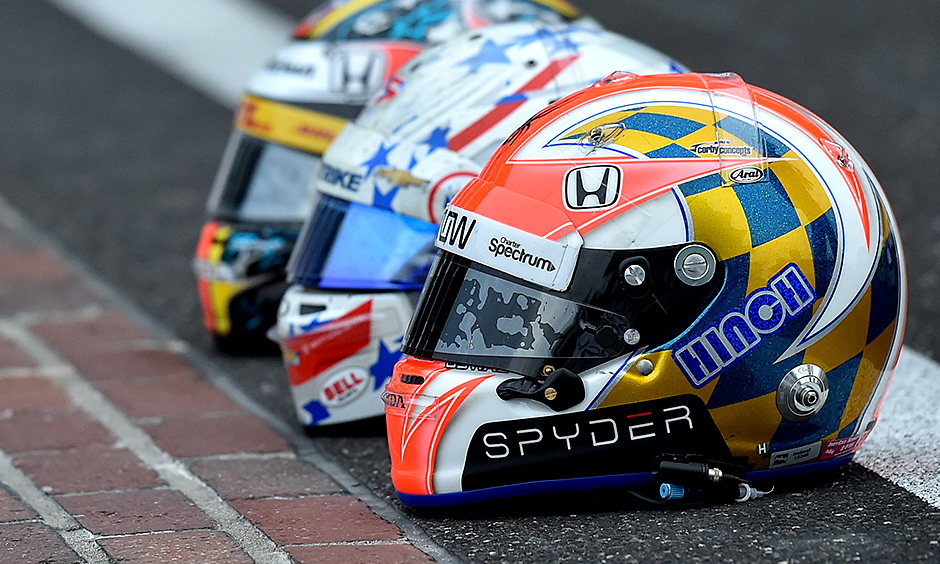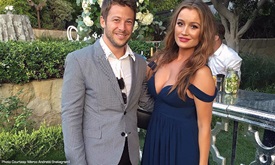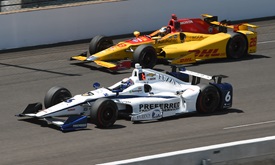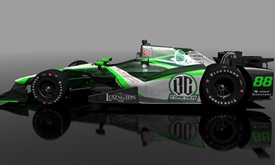INDYCAR drivers take their helmet designs personally
AUG 17, 2016
When drivers land seats with a team in a top-flight racing series, they don't get to decide the color or paint scheme of their cars, or even the style of firesuits they wear. Depending on the circumstances, even the shirts they wear at public events are often left up to the team and its partners and sponsors.
That leaves their racing helmets as one of the only methods of personal expression, something that has made the designs highly personal and cherished symbols of their individuality.
“We don't play basketball where you can see a guy's face on the court. It's a different deal and helmets are really the only piece that drivers have maintained control over through the years and it's become a massively personal thing because of it,” said No. 5 Arrow Schmidt Peterson Motorsports Honda driver James Hinchcliffe.
“For me growing up, I always loved the drivers who kept the same design year-in and year-out. There's something really cool about guys like (1995 Indy car champion and Indianapolis 500 winner) Jacques Villeneuve and (four-time Indy car champion and three-time Indy 500 winner) Dario Franchitti, who had essentially the exact same design their entire career.”
Interestingly, some Verizon IndyCar Series teams, like Team Penske, include helmets as a part of sponsorship deals, which means they often reflect the colors of those whose names are on the car rather than the drivers' personal preference.
“I would love to be able to run my red helmet — it's my trademark and that's how people recognize you,” said No. 22 Team Penske Chevrolet driver Simon Pagenaud. “But, when you have the chance to drive for Roger and they ask you to change colors because you have too many sponsors, it's not a big problem to have. It's a good problem to have and I take it that way.”
Even when the owner doesn`t mandate it, many drivers devote space on their helmets to team partners and personal sponsors.
It's simply a part of racing today, insisted No. 15 Rahal Letterman Lanigan Racing Honda driver Graham Rahal.
And while some might be nostalgic for the days of almost plain but iconic helmets, like those sported by racing legends Mario Andretti and James Hunt, it`s unlikely drivers will be moving back that way anytime soon.
“James Hunt was a bad ass, so he could get away with it,” Rahal laughed. “If the rest of us showed up with a cue ball or just a black helmet like him, we'd be labeled a dork or something.”
Because the helmet design is a highly personal thing, the inspiration for the paint schemes is as varied as the athletes wearing them. Some base their helmets on those of their heroes growing up, some use a family connection or national symbol to anchor the design. In a few cases, it's a matter of pure happenstance.
Here are a few of the stories that shaped the designs and colors fans see at Verizon IndyCar Series racetracks, with explanations from the drivers themselves and accompanying photos to illustrate.
Marco Andretti (No. 27 Andretti Autosport Honda)
"It goes back to my grandfather (Mario, the 1969 Indy 500 winner and four-time Indy car champion) and his sponsorship with Viceroy. He just had a silver helmet with Viceroy and he added a red stripe, so his was just plain silver with a red stripe, and then my dad (Michael, 1991 Indy car champion) added the flag on the side. I adopted both of those but I switched the red stripe (on top) to blue. I didn’t have to do it, but I just thought it was a tribute and something I wanted to keep going for as long as you can. It's sort of your identity and that's cool and it's how you can separate yourself."

Sebastien Bourdais (No. 11 KVSH Racing Chevrolet)
"The design was inspired by a really good kart driver from the 1990s named Nicola Gianniberti. I needed to create a design that I liked based on the colors of the sponsor Duval Espace Fenêtre that really helped us make it through Formula Campus, Formula Renault and Formula 3, so it was yellow, light blue and dark blue. The very first one was a white base with stickers, it was yellow and blue because those were my favorite colors and then a friend of mine who used to be a kart mechanic started a helmet painting business and he did a design with a French theme: red, blue and white. For my first Formula Renault season in 1996, we had big support from Duval Espace Fenêtre and that's when the yellow, light blue and dark blue began. There have been some variations on the little designs inside the blue and the sizes of the stripes, but the colors really haven't changed."

Helio Castroneves (No. 3 Team Penske Chevrolet)
"I had this helmet since I was young. I started with another one but when I decided to design my own helmet in Brazil, I've stayed with that paint job. It's cool, it's been with me for over 20 years in racing and it's become my trademark. I have had multiple colors in the past but the design stayed the same. (Team owner) Roger (Penske) likes to match the colors to the sponsors, so we have changed that and it looks even better when you are out there on the racetrack. A cool thing about it is that we like to embrace tradition, for example in the Indianapolis 500 we went with a Pennzoil colors an used a (four-time Indy 500 winner) Rick Mears helmet design shown below)."

Conor Daly (No. 18 Dale Coyne Racing Honda)
"I downloaded a helmet design sheet from the Internet when I was 12 and I started drawing things on it because I didn't want to have my dad's helmet because it was my dad's; I wanted to be Conor Daly. I tried to draw some stuff with arrows and I really liked the colors blue, green and yellow -- yellow from my dad's arrow. So I came up with a design that was green with a yellow arrow and blue, and that's what I went with and I thought it was cool. But then a lot of people said it was a lot of Brazilian colors and I thought, 'Yeah, I guess they're right.' So I decided that because I like black and green a lot and I love Monster Energy, I got with that and it's been my identity."

Scott Dixon (No. 9 Chip Ganassi Racing Chevrolet)
"I think it's been the same pretty much since about 1993, but it has gone through some color changes. I went to the black and silver, which is the All-Blacks (New Zealand's national rugby union team) and two very prominent colors for New Zealand sporting. Right now, it's back to the blue and red and just a bit of orange for (late Formula One racer and team founder) Bruce McLaren, which is a big part of motor racing for New Zealand and its heritage. The blue and red colors are pretty much off the New Zealand flag with the four stars on the back to represent the four stars on the flag as well, and then on the inlay especially on the front it's got a bit of a moko, which is a Māori design to represent the native people of New Zealand. I try to keep it the same, keep it true to where I first started and where I came from."

James Hinchcliffe (No. 5 Schmidt Peterson Motorsport Honda)
"Fundamentally, it all started with red for Canada and blue and gold for Greg (Moore, the late Canadian Indy car driver shown left below). The two years I switched those colors in junior categories were also the two years I did not win a race, so I decided red or orange on top and blue and gold on the side was what I was going to do. The first half was Greg: The gold and white checkers on the side is very much a Greg-inspired element. The orange on the front actually started as a big red Maple Leaf on the mouthpiece that sort of got stretched over the years and now you have the big orange design down the back and that was just something that I talked out with the guy who painted my first helmet and we landed on that. It's been an almost identical design since about 2006."

Ryan Hunter-Reay (No. 28 Andretti Autosport Honda)
"It was inspired by Greg Moore: The front white area was originally blue and stepped up into Greg Moore's lightning bolt and I had an American flag and instead he had a checkered flag, and it evolved from there. Greg was young and fast and doing everything in life I wanted to do. He was one of the guys who took an extra bit of time to talk to me when I was a kid and went to Indy car races. He definitely made that difference for me. It was that experience from a fan's perspective that you really want. I incorporated an 'H' on the side of the helmet and a white area in the middle for AutoNation. The American flag inside a star was inspired by IZOD and they helped me come up with the center stripe."

Tony Kanaan (No. 10 Chip Ganassi Racing Chevrolet)
"I have had the design since Day 1. It was all about getting girls. I remember sitting at a desk at home with my dad when I was 8 years old trying to draw a helmet design and I didn't know what to do, so he suggested it should be something I like. One of my best friends back then who is actually still my best friend nowadays was this blond kid who was very popular with the girls and he had long hair that he used to put behind his ears all the time. I never had that kind of hair, so basically if you look at the two lines behind the (face shield) opening, that's pretty much it. We picked the red and blue because they were colors of the company my dad used to own, although I changed them now. I dig it and it's too late to change it. I have had it for 33 years."

Simon Pagenaud (No. 22 Team Penske Chevrolet)
"There's a picture of me as a 3-year-old riding an ATV and that's when I started liking engines and speed and everything about it. The helmet I am wearing in the picture (below left), my dad bought me at the supermarket. It's a small plastic helmet that was red with a blue stripe. It meant nothing at the time, but then I never deviated from it for some reason. It was never calculated but I feel plain colors with a single line represents me well. I have the helmet in my collection: It's the first helmet on the right and it's something I have always had in my heart. Red has always been my color: My dad always had red cars when I was a kid and I've always loved red so I guess that's what it is."

Graham Rahal (No. 15 RLL Racing Honda)
"My design started with my dad's (1986 Indy 500 winner and three-time Indy car champion Bobby), but I wanted to make it modern. I have the circular top and I have the red, white and blue like he had, although it's become a bit more black than blue because of (sponsor) Monster Energy. I took his design and tried to make it modern, but now it's kind of hard to even see that and relate it to my dad's design and I actually feel kind of bad about it. My thought initially was to try to pay homage to my dad and it's kind of faded from there. I like the bright colors and lines of mine and I try to be clean and crisp with the design, all at the same time keeping in mind that I am a pretty active sponsor guy, so I try to design my helmet and a lot of sponsor space, so I have logos all over the damn thing but that's what it's all about."




















